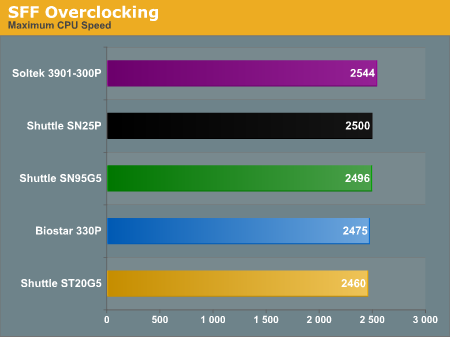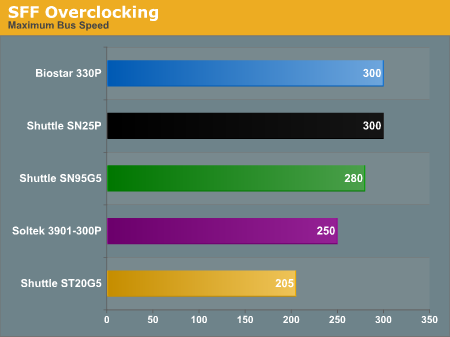Overclocking
We did our best to run all of the systems through some overclocking attempts. In order to conclude that an overclock was successful, we ran our gaming benchmarks, AutoGK, and 3DMark03. 3DMark03 was set to loop continuously and in most instances, we would leave the system running for over 12 hours. Overclocking is always something of a hit and miss proposition, so just because we reached a specific overclock (or didn't as the case may be) doesn't give us any statistical significance. What we offer here, then, is our impression of the overclocking abilities of the various systems.Socket 939 systems are very interesting as overclocking platforms. This is largely due to the relatively low entry price - the 3000+ Venice cores are going for under $150 now - as well as the large amount of headroom available. It is not uncommon to get as much as a 40% increase in clock speed out of the 3000+, but it does require a base Hypertransport speed of 280 MHz or more. In order to run at such high bus speeds, the BIOS and motherboard must be designed well. All of the systems in this roundup include at least basic overclocking support, and while we started with a 2.4 GHz 3800+ processor, the downward unlocked multipliers allow us to verify the maximum attainable bus speed. That's our primary focus for overclocking, and it determines whether we feel enthusiasts looking to get high-end performance for low-end prices will find a system to be suitable or not.
While we are including a "maximum CPU overclock" result, take the numbers with a grain of salt, as we didn't thoroughly investigate every possible combination of settings that might lead to a slightly better overclock. If a unit can reach a high CPU bus speed setting, you'll have plenty of options for reaching a good overclock.


The ST20G5 is on the other end of the spectrum, with virtually non-existent overclocking support. Whether this was caused by the chipset, the BIOS, or something else is anyone's guess, but for now, we would simply say to forget about any overclocking attempts if you buy the ST20G5. We'll see if we can get any better results with an updated BIOS or different processor in Part 2, but while we could POST and boot Windows at up to 225 MHz CPU bus speeds, certain benchmarks would always crash the system. Without overclocking, however, we experienced no stability issues with the ST20G5 at all.
It's interesting to note that the old Shuttle SN95G5 is one of the top overclockers, and we were able to use 1T timings at all bus speeds. We were able to run the SN95G5 at a 275 MHz bus with a 9X multiplier to reach 2475 MHz, and we were also able to reach its maximum 280 MHz bus with an 8X multiplier. While 280*9 is 2.52 GHz and we've been able to run this particular 3800+ at up to 2.54 GHz in other systems, that particular combination was not stable for the SN95G5.
The Soltek comes in second to last for overclocking, reaching its maximum 250 MHz bus, but only when setting the RAM to DDR333. On the other hand, using the 12X CPU multiplier, we were actually able to get the highest CPU speed of any of these systems from the Soltek. We only wish that the Soltek had support for higher CPU bus speeds than 250 MHz.
Note: The use of a HyperTransport bus combined with an integrated memory controller can make talk of overclocking on Athlon 64 systems a bit confusing. In practice, a 250 MHz CPU bus with a 4X HyperTransport multiplier would have the same HyperTransport bus speed as a 200 MHz CPU bus with a 5X HT multiplier. The difference is that the CPU bus speed also influences the RAM speed. Another interesting option is the use of different DRAM ratios, which are really estimates of a CPU ratio. Our 3800+ running at stock speeds has a 200 MHz CPU bus with a 12X CPU multiplier and a 5X HT multiplier, and we can run 2-2-2-7-1T RAM timings on these systems. For all practical purposes, running the 3800+ with a 240 MHz bus and a 10X CPU multiplier with a 4X HT multiplier results in the same CPU clock speed of 2.4GHz and also keeps the RAM at DDR400. However, as the ST20G5 shows, just because they're the same speed in practice doesn't mean that all motherboards and chipsets will actually function properly at higher CPU bus speeds.










29 Comments
View All Comments
JarredWalton - Friday, August 12, 2005 - link
I'll hit the KLOSS as soon as I can. (I have it already.) So unless someone else votes, I guess I'll get the KLOSS reviewed next.Sokolum - Thursday, August 11, 2005 - link
For the last 2 months now i have a ST20G5 using as a MCE system. There are a few problems what i have encounbtered, one of them is that the system behaviour changes when i change a setting within the BIOS. Those aren't dramatic changes. But with every change, it looks like that the graphics runs muchmore slower, you can see this with dragging a windows screen over your desktop, you get trails from that window...The system only runs smooth when i *don't* touch those setting. Happily the things keep running smoothly when i enlarge the shared video memory.
For the MCE side, i failed to make the Hauppauge 500MCE run compleetly as it should, i am only able to run TV 'Tunner 1' without problems when i *disable* TV 'Tunner 2' within windows Device Manager. Shuttle or Hauppauge couldn't help me with this case.
As the review documented, this is one of the cases that RAID is causing the problem in this story. In my MCE setup, i don't use RAID (there is *no* room for a seccond drive when you installed a floppy drive). Why RAID is the problem, what i have been told is that RAID wants to use al of the PCI bandwith. It seems the nature of RAID in this kind of systems, just een told, i am not for 100% sure, but it seems plausible to mee.
, a nice looking machine. I solved the problem for the flash cards with buying a floppy disk what come with a integrated card readed, see link:
http://www.alternate.nl/html/shop/productDetails.h...">http://www.alternate.nl/html/shop/productDetails.h...
mino - Thursday, August 11, 2005 - link
Jared I must confes, this is the _first_ time i see everclocking test done as it should have been. I really appreciate the comments for newbies (it makes easier to me to explain to them if you could reference somthing :). Also finally use of correct term oo A64 base freq./FSB issue. I think this way is it should be done for _all_ A64 motherboard review.1) do a maximum base freq. check (by keeping memfreq. around DDR400 + CPU not overclocked
2) do a max memclock test at 1T (with some proven components, just to check quality of CPU to MEM routing on the MB)
3) do some max. overclock test (actually this may be optional since it depend mostly CPU chosen)
Keep at this route and many readers may finaly undestand the basics of A64's OCing.
JarredWalton - Thursday, August 11, 2005 - link
I'm working on some detailed overclocking articles right now. Glad you enjoyed the section, and I'll be going into a LOT more detail (with benchmarks) on some future OC articles.dropadrop - Thursday, August 11, 2005 - link
Thanks for the nice review,If you are considering a followup I would love to see you test usb. While the usb on my sn95g5 v2 works for casual things like a mouse, digital camera and memory card reader, it does not work for an ipod shuffle, external soundcard (hercules dj console), or external hardisk.
There have been alot of people with similar experiences. It wold be great if you could find a way to test the sff's with a few "demanding" usb devices, and even measure the voltage (and stability of it) supplied via usb.
I also second the request for you to test the sn95g5 with an X2. The new bios surely supports them, as people in north america have been getting their current rigs modded by shuttle for support. I would love to see how your's supports it (and maby even venice / san diego) without being modded. I believe you would have the chance to help alot of confused SN95G5 users by trying out a few cpu's in it.
JarredWalton - Thursday, August 11, 2005 - link
I will definitely give it a shot. At present, my intention is to purchase an external IDE HDD enclosure with USB2.0 and 1394A support and do some file transfers and such between that and the system. The problem with that approach is that the enclosures all have an external power source. Can anyone recommend an inexpensive USB/Firewire HDD enclosure that gets the power over the USB port? http://www.newegg.com/Product/Product.asp?Item=N82...">I found this one, but I'm not really keen on spending $160 for something I don't personally need.dev0lution - Wednesday, August 10, 2005 - link
How come the SN25P details don't mention the update from nforce4 standard to nForce4 Ultra? I'm thinking of getting one so I went to the previous review and it lists chipset in the specs as the nForce 4 standard, but if you go to Shuttle's current product page for the SN25P it lists the chipset as the Nforce4 Ultra. Who's correct?JarredWalton - Thursday, August 11, 2005 - link
I think I may have just been lazy or neglectful in the original SN25P article. I'm pretty sure it was always nForce4 Ultra. Then again, regular nf4 vs. nF4U only adds SATA-II support IIRC. I don't see anything about SN25P supporting SATA-II which is sort of odd.Cookie Crusher - Wednesday, August 10, 2005 - link
I know it may be a "dated" or more "Entry Oriented" socket, but I have found that the socket 754 SFF systems are great for gaming and general use. Was there ever a roundup for them? If not, I'd like to see maybe a limited look at them to remind everyone that they are viable alternatives to, and about $75-$100+ cheaper than, these socket 939 options.I think it's important to point this out because of the note in the article that a SFF option incurs a premium....maybe so, but there are still cost effective options in that market. thanks.
Cookie Crusher - Wednesday, August 10, 2005 - link
Nevermind.....i found the roundup I was hoping for.....still, would be nice to make that reference to the older socket types as legitimate choices for SFF hopefuls on a budget. :-)